英文演讲的常用句型
- 格式:ppt
- 大小:4.43 MB
- 文档页数:29
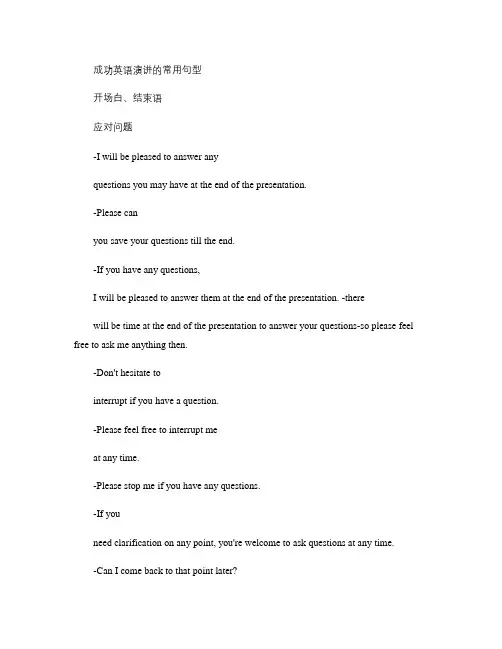
成功英语演讲的常用句型开场白、结束语应对问题-I will be pleased to answer anyquestions you may have at the end of the presentation.-Please canyou save your questions till the end.-If you have any questions,I will be pleased to answer them at the end of the presentation. -therewill be time at the end of the presentation to answer your questions-so please feel free to ask me anything then.-Don't hesitate tointerrupt if you have a question.-Please feel free to interrupt meat any time.-Please stop me if you have any questions.-If youneed clarification on any point, you're welcome to ask questions at any time.-Can I come back to that point later?-I will be coming tothat point in a minute.-That's a tricky question.-We will gointo details later. But just to give you an idea of...-I am afraidthere's no easy answer to that one...-Yes, that's a very good point.-Perhapswe could leave that point until the questions at the end of the presentation -I think I said that I would answer questions at the endof the presentation---perhaps you wouldn't mind waiting until then. -I think we have time for just one more question欢迎听众 (正式-Welcome to our company- I am pleased to be able to welcome you toour company...- I'd like to thank you for coming.- May I takethis opportunity of thanking you for coming欢迎听众 (非正式- I'mglad you could all get here...- I'm glad to see so many people here.-It's GREat to be back here.- Hello again everybody. Thank you forbeing on time/making the effort to come today.- Welcome to X PartII.受邀请在会议上致词- I am delighted/pleased/glad to have the opportunity to present/of making this presentation... - I am gratefulfor the opportunity to present...- I'd like to thank you forinviting/asking me/giving me the chance to...- Goodmorning/afternoon/evening ladies and gentleman- It's my pleasantduty today to...- I've been asked to...告知演讲的话题- thesubject of my presentation is...- I shall be speaking today about...-My presentation concerns...- Today's topic is...- Today we arehere to give a presentation on...- Today we are here to talkabout...Before we start, I'd like you meet my team members... - Abrief look at today's agenda...(告诉听众所讲内容的先后顺序 - Before we start our presentation, let's take a brief look at the agenda...- I shall beoffering a brief analysis of...- the main area that I intend tocover in this presentation is...- Take a moment and think of...-Thank you for giving me the opportunity to tell you about... 告诉听众发言的长度- During the next ten minutes, I shall...- I shall bespeaking for about ten minutes...- My presentation will last forabout ten minutes...- I won't take up more than ten minutes of your time...- I don't intend to speak for longer than ten minutes...-I know that time is short, so I intend to keep this brief- I have alot to cram in to the next ten minutes, so I'd better make a start... 引起听众的兴趣- I'm going to be speaking about something that is vitallyimportant to all of us.- My presentation will help solve a problemthat has puzzled people for years...- At the end of thispresentation you will understand why this company has been so successful for so long...- I am going to be talking about a product that coulddouble your profit margins...- the next ten minutes will changeyour attitude to sales and marketing...- Over the next ten minutesyou are going to hear about something that will change the way your companies operate...- By the end of this presentation you will knowall there is to know about...告诉听众内容要点- there are five mainaspects to this topic (...the first, ... the second, ...a third,...another, ... the final- I am going to examine these topics inthe following order (...first, ...next, ...after that, ...finally-I've divided my talk into five parts...- I will deal with thesetopics in chronological order...- I'm going to start with a generaloverview and then focus on this particular problem (...in general, ...more particularly.- I want to start with this particular topic,and then draw some more general conclusions from it (...specifically, ... in a wider context.- there are (a number of factors that mayaffect...- We have to take into account in any discussion of thissubject, the following considerations.- We all ought to be aware ofthe following points.结束语-In conclusion, I'd like to...-I'dlike to finish by...-Finally...-By way of conclusion...-Ihope I have made myself understood-I hope you have found thisuseful-I hope this has given you some idea/clear idea/an outline of...-Let me end by saying...-That, then was all I had to sayon...-That concludes our presentation...-I hope I've managed togive you a clearer picture of...-If there are any questions, I'd bedelighted to...-Thank you for your attention...-Let's break for acoffee at this point-I am afraid that the clock is against us, sowe had better stop here-You have been a very attentiveaudience---thank you转自 /abc/html/kouyujicui/20070821/4.html转帖二做 presentation ,我们要注意对话题的准备以及态度和身体语言等等,除此之外, 我们还应该掌握一些常用句型。

2023-11-06•欢迎和开场白•连接和过渡性语句•表达观点和论证目录•应对问题和挑战•结论和总结•表达情感和呼吁行动01欢迎和开场白问候语Good morning/afternoon/evening, everyone.Hello, everyone. It's a pleasure to see you all here.Good to have you all here today.I hope to share some valuableinsights with you today.自我介绍My name is [Your Name], and I'llbe your speaker today.I'm an [Your Field] expert with years of experience in [Your Areaof Expertise].Thank you all for coming.I appreciate your time and attention.I'm grateful for the opportunity to speak with you today.表达感谢02连接和过渡性语句表示顺序或步骤Firstly Secondly Array 用于进一步阐述前面的步骤或顺序。
通常用于开始一个步骤或顺序的描述。
Thirdly Finally用于继续阐述前面的步骤或顺序。
通常用于总结和结束。
连接两个段落用于总结前文并进入下一主题。
In conclusion用于在保持话题一致性的同时,引入新的观点或信息。
In addition用于进一步阐述前文内容,常用于连接两个相关的观点或事实。
Furthermore 用于强调前文内容,常用于连接两个相关的观点或事实。
Moreover用于转折,引出与前面话题不同的观点或情况。
However用于引入与当前话题相关的另一个观点或信息。
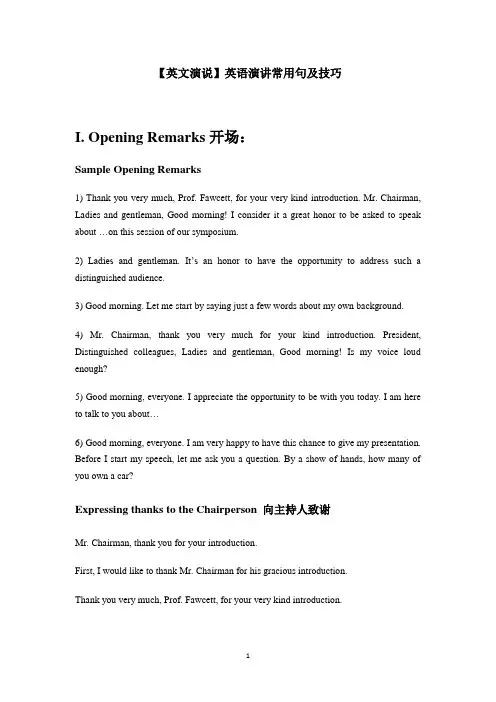
【英文演说】英语演讲常用句及技巧I. Opening Remarks开场:Sample Opening Remarks1) Thank you very much, Prof. Fawcett, for your very kind introduction. Mr. Chairman, Ladies and gentleman, Good morning! I consider it a great honor to be asked to speak about …on this session of our symposium.2) Ladies and gentleman. It’s an honor to have the opportunity to address such a distinguished audience.3) Good morning. Let me start by saying just a few words about my own background.4) Mr. Chairman, thank you very much for your kind introduction. President, Distinguished colleagues, Ladies and gentleman, Good morning! Is my voice loud enough?5) Good morning, everyone. I appreciate the opportunity to be with you today. I am here to talk to you about…6) Good morning, everyone. I am very happy to have this chance to give my presentation. Before I start my speech, let me ask you a question. By a show of hands, how many of you own a car?Expressing thanks to the Chairperson 向主持人致谢Mr. Chairman, thank you for your introduction.First, I would like to thank Mr. Chairman for his gracious introduction.Thank you very much, Prof. Fawcett, for your very kind introduction.I would like to thank Dr. Huang (主持人或推荐你来发言的上司)for permitting me the privilege to speak to this audience.Forms of Address and Greetings对听众的称呼Distinguished colleagues, Ladies and gentleman, Good morning!Members of the conference!Expressing Pleasure and Honor 向听众致意I am very happy/glad/pleased to be here in Hong Kong.I am honored/privileged to be here (with you this afternoon).I am proud to be here on this special occasion.It’s a very great pleasure for me to be able to attend this conference.I consider it a great honor to be asked to speak about …on this session of our symposium/ at this conference..It is a great pleasure to be given the honor of first speaker on this important topic.Others 细节,如确认话筒音量Can you hear me all right?Is my voice too loud?Reference to the Audience 与听众呼应I can see many of you are from …department.I know many of you are familiar with this topic.You all look as though you’ve heard this before.I understand that you’ve all traveled a long way./ After hours of conference, you must feel a little tired. Now I’d like you to see an interesting topic…II. Introducing the Subject and the outline of the Presentation引入话题Background InformationI would like to start by briefly reviewing the history of open heart surgery.Let us start with the theoretical basis of this new technique.To begin with, we have to consider the principle.I think it would be best to start out by looking at a few slides.I should like to preface my remarks with a description of the basic idea.May I begin with a general outline of this project?The first thing I would like to talk about is the definition of the terms I shall use in my lecture.The first point I'd like to make is the historical background of the invention.First, I shall explain to you why this new program is correct and feasible.TopicI would like to concentrate on theproblem Of antibiotic abuse in hospitals.I shall devote my talk to the surgical treatment of coronary disease.I want to confine my talk to the latest developments in civil engineering.Today, I am going to give a talk on the application of computers in medicine.My topic today will deal with the observation of supernova.In today's talk, I' 11 restrict myself to the etiology of 15-epa~i;s.In my presentation this morning, I' 11 limit myself to three major points only.I take the liberty of restricting my discussion mainly to highway bridge construction.Now, I would like to address myself to the most important aspect of this problem.Among the many languages, I shall mention only BASIC.What I am going to present today is the methodology and the data analysis.I'm not going to say much about that except to discuss the literature on that topic.OutliningMy talk today consists of two parts. One is... and the other is...I've divided my presentation into four parts.I shall first talk about ... and then touch on... and finally discuss ...The subject can be looked at under the following headings: ... (Pointing to the PowerPoint display)I would like to divide my talk into two parts. The first part deals with…, the second part concerns ...My presentation will be given in four parts. The first part deals with ... The second part relates to... The third part concerns ... And the last part discusses…Purpose/ObjectiveThe purpose of this presentation is to...This talk is designed to…Comprehensive SamplesSample 1Thank you, Mr. Chairperson, Mr. Director-General, distinguished members of the ILO's Governing Body and friends. I welcome this opportunity to be here today, with an Organization which in many ways belongs to all of us workers. I can think of, in fact, no other international body that one can claim as one's own so unambiguously.I have also had a longstanding formal association with the ILO. Many of my early pieces on women and technological change and on land rights were published by the ILO, as well as was the work of many other scholars. It is therefore a pleasure for me to be here on this important Symposium.The canvas of the Symposium is very large. I will focus on two aspects of gender inequality that centrally effect millions of women as workers but perhaps have failed to receive the attention they deserve. First, the gender gap in command over property and Productive assets and, second, gender biased social perceptions and social norms.Sample 2I learned last May that you have to be careful in speaking to a group of professional communicators. After I conducted a writer' s workshop at the Toronto Conference of the International Association of Business Communicators, Janine Lichaczwrote asked me to speak here tonight and used the communication techniques I had recommended. She even included a footnote citing my lecture. I am susceptible to good communication and to flattery so I am pleased to be with you to discuss your topic for the evening, the use of language in the art of speech writing.I suppose we must begin by shaking our heads, woefully, over the sad state of language today, whether in formal speeches, casual conversation, or in writing. Most of us in this room no doubt agree with the generally negative tone of Time Magazine's year-end assessment which claims “our language has been besieged by vulgarities”. But to preserve our sanity as professionals in communication of us would probably join Time in optimistically expecting English somehow to survive and even to prosper.Expressions on Other OccasionsCorrecting the Title of the PresentationFirst of all, I would like to mention that the title of my presentation should be ...Please allow me to correct a mistake in the title of my speech which appeared in the program. Instead of... it should read...Reading. Another Person's PaperSometimes you are selected to read another person's paper, as he or she is absent.I shall read a paper by Dr. Li from Guangzhou, china, who regrets that he could not be here. The title of his paper is...I'm going to read the paper by Dr. Wang. It's a great pity that, because of a health problem, he could not be here.I was asked by the author to read his paper. He apologizes for not being able to come here.The next speaker, Prof. Zhang, regrets that she could not be here and has submitted her paper to me. I am not sure if I can present it as well as she expected.I am not sure whether I' 11 be able to be very confident in answering specific questions. However, I am somewhat familiar with his work, so I' 11 try my best.Checking the MicrophoneFirst I want to check if all of you can hear me clearly.Am I speaking clearly and loudly enough for those in the rear of the room?I wonder if those in the rear of the room can hear me.If those in the rear of the room can hear me, would someone please raise his hand?Can you hear me clearly?Can you hear me if I am away from the microphone?Is the microphone working?* Summary-How to Prepare a Good IntroductionRealize file great importance of the introduction of file presentation mad then do your best in delivering it.Don' t make file introduction either too wordy, or too brief. Usually, it covers 10 to 15 percent of your entire speech.Select tile ways to capture the audience attention.Indicate tile topic.Outline your Speech.Announce your purpose.Prepare several versions of tile introduction, compare them, and then select the best version. Finally, learn it by heart so as to be able to deliver it easily mid fluently.Don't start your speech with apologies.Pay attention to your body language.Chapter II Developing the Speech TextI. Announcing the Beginning of the Speech TextTo begin with, I would like to talk about a principle.I think it would be best to start out by looking at some pictures.The first thing I would like t o talk about is the definition of the terms which I’11 use in my presentation.II. Shifting to the Next Main PointWell, let's move on to the next point.We will now come to the second problem.Turning to the next question, I' 11 talk about the stages of the procedure.As the second topic, I shall stop here. Now let' s turn our attention to the third topic.So much for the methodology of our experiment. I would now like to shift to the discussion of the results.Now, let's move away from the first part and switch over to the next part of my presentation.That's all for the introduction and now we can go on to the literature review.Next, I would like to turn to a more difficult problem.The next point I'd like to talk about is the feasibility of this project.That brings me to my second point.I am glad that we can now leave this rather boring subject of mathematic deduction and go into a more attractive one, that is the application of the formula.III. Resuming the TopicLet' s come back to what I said in the first part of my speech.Getting back to the subject of the problem of theoretical considerations we can find that...I want to return to the first part of my presentation.Now, to get back to the effect of temperature, you may be aware that the problems have been solved.This brings me back to the question of security.At this point I would like to refer again to the question of methods in the first part of my lecture.Referring again to the first question, I think...Referring to the Coming PointI'll deal with it later.I' 11 touch upon that point in a moment.I shall tell you in detail shortly.IV. Introducing the Supporting MaterialsI think this part is the most difficult, so I'll explain it in greater detail.I think this part of my paper is most important, so I plan to spend more time on it.Please allow me to deal with this matter more extensively.Being the most important part of my presentation, I will elaborate on it with more slides.I' 11 expand this topic with drawings and figures.Indicating the Points BrieflyLimited by the time available, I can only give you a very brief account of this matter.I don't think that I should describe the methods in detail, because they are included in the handout.I will not go into detail on it.This point has been talked about repeatedly in this symposium, so I am not going to spend too much time on it.Let's go through the following points very rapidly.I just want to outline for you what I experienced in using this new drug.I shall not go over all these explanations. My time is running short. So I'’11 be brief.It is sufficient to say that these experiments were poorly designed and without controls.V. Repairing a Slip of ToneThe first of such experiments began in 2000, rather than 1999.May I have the lights, I mean the slides.The temperature increased, I shall say decreased.The population is 13 million, sorry, 31 million.The exchange rate dropped from 2.5 to 1.8, I beg your pardon, 1.9.As you can see from the first row, excuse me, the second row, that the output increased two fold.VI. Expressions Concerning Audio-Visual AidsCould we have the lights off? And the first slide, please.Lights off, first slide, please.Dim the lights, and first slide, please.The slide is not so clear. Please darken the room a little more.Could you please turn on the lights, please?Now, we can have the lights on.Please switch on the lights.Lights on, please.I apologize that this slide is not so clear, but I hope you can still make out the general idea.Sorry for the small print.I'm sorry we left a figure out here.VI. Explaining the Contents on the SlidesThis slide demonstrates ...On this slide, you can see...This curve in this slide shows...This figure in this slide exhibits...This table on this slide presents...This diagram on this slide depicts...This chart on this slide displaces ...The picture on this slide shows ...The photomicrograph on this slide shows ...The flow-chart on this slide points out...The circuit diagram on this slide represents~...~Indicating the Sources of the Content in aThis figure is taken from.., by Dr. Li.This diagram is after that of Prof. Wang with some modificationVII. Demanding to Show the Next SlideMay I proceed to the next slide, please?I think we can move on to the next slide.Let me show you the next slide.Now, we can go on to the next slide. 'Next slide, please.Next, please.Next !VIII. Returning to the Previous SlideTo make a comparison, can we return to the first slide, please?Let's go back. No, not this one. One back. Back one more. Yes, that’s it. Thank you. May I go back two slides, please?Could you return to the second slide?May we have the previous slide again?IX. Correcting a MistakeSorry, this one is in the wrong order. May I have the next one?Oh, this slide is misplaced. Please skip over it. Yes, this is the correct one.I'm afraid I didn't ask for this slide. Can we go back to the previous one? Please. No, not this one. Next, please. Yes, this is the one I need. Thank you.I'm afraid you may have lost one slide which is a flow chart of the procedure. Sorry, there seems to be one slide missing.X. Indicating the Speed of Running SlidesLet's go through the following slides rapidly.The following three slides we will go through quickly without explanation.Wait a minute, please. I want to say more about this slide.Because of the shortage of time, I' Il have to omit the following slides.Time is up, let's come to the last slide directly.Would you please skip the next slid-e and go on to the table?Next, next. Go ahead... That's it.Chapter III Ending the Speech TextI. Signaling the Beginning of the End PartLet’s look at what I have talked about.Well, that brings me to the end of my presentation. This last slide is a brief summary of what I have talked about.Before I stop/finish, let me just say...To close my speech, I' 11 show you the last slide.Now I'd like to summarize my talk.To summarize, I have talked about three aspects of the cancer problem: ...Finally, as a summary statement, I would like to sum up the major points I have made. II. SummarizingLet me just run over the key points again.I'll briefly summarize the main issues.In conclusion,…In closing,…In a word,…To sum up ...In brief,…Briefly.......All in all,…Finally,…III. ConcludingAs you can see, there are some very good reasons ...To sum up, my conclusion is that the present program is the best one.In conclusion ...Let me conclude my talk with the following comments.Allow me to conclude by listing out all the factors influencing the efficacy. In conclusion, I would like to point out the following aspects.I'd like to leave you with the following conclusion.IV. QuotingLet me close by quoting Dr. Einstein, the famous physicist, who said tha t…I would like to come to a close by quoting what Sir Newton once said...Therefore, I would suggest that we...I'd like to suggest...As far as I'm concerned, the only solution to the problem is...V. ClosingThat's all, thank You.That's the end of my presentation.So much for my speech, thank you.Thank you for your attention.Thank you for your listening.Other Expressions that May Be Useful in the End Part of the SpeechSorry, I see the red light is shining so I have to skip the last part and jump to the conclusion.Mr. Chairman is signaling me, I have to stop here and leave out the remaining part to spare time.VI. Samples[ Sample 1 ]We have proposed a framework of a hierarchical planning system for robots. First of all, the system is an automatic plan system that can guide the robot intelligently in terms of the environment. Secondly, it is based on hierarchical planning. The planning problem has been hierarchically decomposed into two sub-problems: global destination selection and local motion planning. And finally, the simulation and application has proved it as an effective design.(Show the last visual)That's all for my presentation. For any question to be raised, I'm quite willing to discuss them with you at any time. Thank you, every one.[ Sample 2 ] 'Finally, we can draw the conclusion: edge detection and denoising are two important branches of image processing. If we combine edge detection with denoising, we can overcome the shortcomings of the commonly-used denolsing methods and without blurring the edge notably.Furthermore, there are many denoising and edge detection methods now. Different methods are suitable for different types of images and noise models. We can do further research on how to combine these various denoising and edge detection methods according to the content of the images and nature of noise.That's all for my talk. If you have any questions, please do not hesitate to ask me. I'm quite willing to discuss them with you at any time, Thank you.[ Sample 3 ]That's all t wanted to show you about Machine Vision and one of its applications, AGV. Thank you OK, that is all I'm going to talk today.Thank you ![ Sample 5 ]That's all. Thank you!Chapter IV Asking and Answering QuestionsI. Inviting QuestionsSo, let's throw it open to questions.Now I' d like to answer any questions, if you have any.Now I am ready to answer your questions, if any.I'd be glad to try and answer any questions.Are there any questions?Any questions?II. Raising QuestionsSignaling Your Intention to Ask a QuestionI want to ask Dr. bi a question.I have a guest ion for Dr. Anderson.Mr. Smith, I have a question to ask you.There is a question I'd like to ask Prof. Li.A question for Mr. Liu.One question, Dr. Wei.Could I ask you a question, Prof. Li?May I venture to ask Prof. Zhang a question?Expressing Your AttitudeBefore asking your question, you can express your positive attitude or make a comment on the speaker's presentation. For example,Dr. Johnson, I was fascinated by your description of your study, but what will happen if...Mr. Li, you did splendid work! Just one question.Asking the Specific QuestionYou mentioned very briefly that you used two experiments that were the same.Would you please elaborate on that point?Would you be so kind as to give me more information about the method of your experiment?Would you tell me the reason why you set such a high temperature?Comprehensive SamplesDr. Wang, I'd like to raise one question. First, may I say how much I enjoyed talk. But, may I ask, do you have experience with the new method?Congratulations, Dr. Li. I can't help but admire your achievement. But I want to know what's your attitude toward abuse of antibiotics?I'd like to congratulate Mr. Liu on a very interesting presentation.May I ask you a question? How does subjective evaluation differ from objective evaluation?First, I'd like to say your research is very interesting. May I ask two questions? Do you see any relation between cigarette smoking and peptic ulcers? And what advantage do you expect by using this approach?III. Response to QuestionsAsking for RepetitionPardon, I couldn't hear what you said.I beg your pardon, I didn't catch what you said.I'm sorry I forgot your first question. Would you be so kind as to say it again?I'm not quite surge what your question is.I didn't quite get the last point of your question.You mean, there may be some mistake in the calculation?Are you referring to the significance of the difference?Are you suggesting that the temperature might have affected the results?If I understand you correctly, you are saying/asking...I didn't quite catch that.Could you go over that again?I'm not sure what you're getting at.Welcoming the QuestionWelcome the question by saying "thank you" or commenting on it saying "That’s a good question" or "That's a challenging question."This is a very good question.Thank you for that question.I'm glad this question has been brought up-I appreciate that question.This is a hard question.This is an interesting question.This is a big question.I'd be delighted to answer your question.I'll try to answer this question very briefly.In answer to your question, I would say that...I can only provide a partial answer to that question.Let me try to answer your questions one by one.My answer to your first question is...May I answer your second cjuestion first?I have only a partial answer to your question.Thank you for that question. This is a challenging question and I'm afraid I can only provide a partial answer to it. Anyway, I'll try my best to answer it.Repeating or Paraphrasing the QuestionQuestioner: Have you tried it on human bodies?Presenter: This gentleman would like to know whether we have tried this on human bodies.Responding to Difficult or Challenging QuestionQuestion: So what happens if the new budget isn't approved?Answer (1): We've spent two months preparing the new budget. It's a good budget and we're confident we'll get approval to put it into practice.Answer (2): There is too much supposition in the question for me to give a sound answer.The following are some other examples of answers to challenging questions:Perhaps in another year or so we can answer that question, because these studies are now in progress.We are now working on this problem and, if you agree, I'll answer your question in a few weeks.The only answer I can give at present is to wait a few more years, at which time something better might ultimately come out of all our efforts.I think it will be possible to answer this question when more experiments are completed.The answer to this question needs further study.I hope I will be able to answer your question later.Responding to Improper QuestionI appreciate your interest in my research, but I just don't want to talk about it now. Let's talk about something else.I'd rather not say.Why do you want to know?Sometimes you can relay the question back to the questioner. For example,Before I answer you that question, let me ask you: where do you think we should have the project?In this way, sometimes you encourage the questioner to answer his or her own question, e.g. "What do you think? Are people prepared to pay an extra $ 2 for faster service?"Responding to the Questions You Do Not KnowIf you don't know the answer to a particular question, simply admit that you don't know. Say something like this:"I'm sorry. I don't happen to know the answer to that question, but I'll be happy to check into it for you."Here are some further examples:I don't think I can answer your question.I wish I could answer your question, but unfortunately I have no good answer.I'm not sure that I can answer your question. What I'm going to say is not quite an answer to your question.Another technique to cope with the situation is to direct the attention to another expert who may know it or you can use the audience. Ask if anyone could help the questioner and hence it won't be necessary for you to admit that you do not know the answer. See examples below.I think that question could be better answered by Dr. Liu than by me.I think perhaps Dr. Chen would be better able to answer this question.Prof. Li would be a better person to answer your question since he has done a lot of work in this field.Fortunately, Prof. 'Ma, who is an authority in this area, is 'here. I think no one is more suitable than him to answer your question.Dr. Sawyer is perhaps in a better position to tell us something about it.Perhaps my colleague Dr. Emery here has some better ideas.I think it would be better if Prof. Wu were to make some comments on this matter.Avoid using the following expressions to embarrass the questioner:"I've already answered that but you obviously weren't listening." Instead say something like "I'm sorry I didn't explain that clearly."Avoid talking to one questioner. Look towards the other, side of the conference hall or room and indicate that there is another question. Suggest that as there are several more questioners,' yon could discuss his or her question in more detail after your talk.Referring Back to the QuestionerHaving finished answering questions, you should check that the questioner is satisfied or further elaboration or explanation is called for. The following expressions might be helpful.Did I answer your question?Did I answer you satisfactorily?Did your question get answered?I don't know whether this answered your question.I don't know if this is a satisfactory answer.I hope this may serve as an answer to Dr. Li.I hope this answers ~0ur question.:,Sometimes when question lime is over and ff time permits, you can restate, your main proposition, including any good comments from the audience and ignoring adverse questions or remarks. Thus, you demonstrate that you are confident mid can cope calmly with controversy.Remember that your last words to the audience will be retained longest and you are expected to behave in a professional manner.Chapter V Talking During the BreakI. Useful encouraging phrases to show your interest and to stimulate the flow of conversationThen what happened? Good. Ah.Really? Right. That's right.Oh? Right, I will. Go on...Oh, hmm. I think it's a good one. For instance.Yes. No. For example.Yes, of course. Sorry, I can't. Such as.Yes, that's right. I'm afraid not. Tell me more.Yes, I do. Well, not really. Then?Yes, he was. Perhaps not difficult. Really?Yes, we were. Erin, I don't know. Is that right?Very nice. I really can't manage it. Is that so?Very good. Not very nice. Are you sure?Very clear. Very bad. (laughter) .....Really nice. Very disagreeable.Quite nice. Really nasty. (silence...)Quite, absolutely true. Aha.II. Informal Talking between ParticipantsA Conversation between Two Old Friends at Coffee BreakA: What would you like?B: A coffee, please.A: I'm sorry I couldn't meet you at the airport. I had to pick up Dr. Abel and bring him here. ,'。
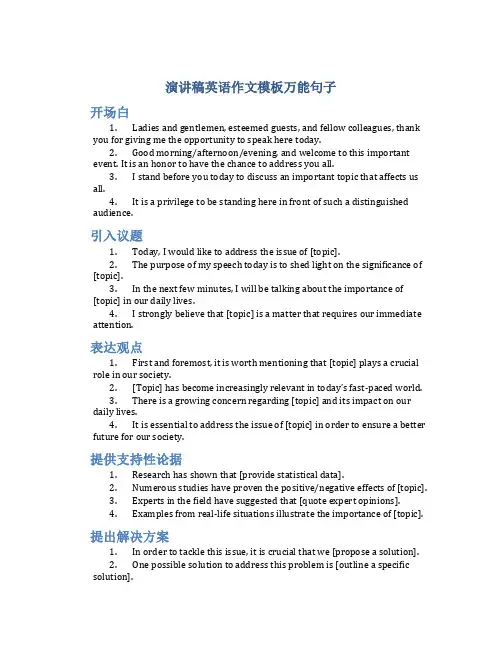
演讲稿英语作文模板万能句子开场白dies and gentlemen, esteemed guests, and fellow colleagues, thank you for giving me the opportunity to speak here today.2.Good morning/afternoon/evening, and welcome to this important event. It is an honor to have the chance to address you all.3.I stand before you today to discuss an important topic that affects us all.4.It is a privilege to be standing here in front of such a distinguished audience.引入议题1.Today, I would like to address the issue of [topic].2.The purpose of my speech today is to shed light on the significance of [topic].3.In the next few minutes, I will be talking about the importance of [topic] in our daily lives.4.I strongly believe that [topic] is a matter that requires our immediate attention.表达观点1.First and foremost, it is worth mentioning that [topic] plays a crucial role in our society.2.[Topic] has become increasingly relevant in today’s fast-paced world.3.There is a growing concern regarding [topic] and its impact on our daily lives.4.It is essential to address the issue of [topic] in order to ensure a better future for our society.提供支持性论据1.Research has shown that [provide statistical data].2.Numerous studies have proven the positive/negative effects of [topic].3.Experts in the field have suggested that [quote expert opinions].4.Examples from real-life situations illustrate the importance of [topic]. 提出解决方案1.In order to tackle this issue, it is crucial that we [propose a solution].2.One possible solution to address this problem is [outline a specific solution].3.We need to take immediate action by implementing [specific action]to combat this issue.4.By working together, we can find innovative solutions that will lead toa positive outcome.呼吁行动1.I urge each and every one of you to take action and make a difference.2.It is our collective responsibility to address this issue and findeffective solutions.3.Let us join hands and work towards a better future for ourselves andfuture generations.4.By taking small steps in our daily lives, we can contribute to theoverall solution.结束语1.In conclusion, it is essential that we prioritize [topic] for thebetterment of our society.2.Let us stand united in our efforts to overcome this challenge andcreate a brighter future.3.I hope that my speech has shed some light on the importance of[topic].4.Thank you for your attention and I look forward to discussing thistopic further.以上是一份演讲稿英语作文模板的万能句子,希望能对您的演讲稿写作有所帮助。
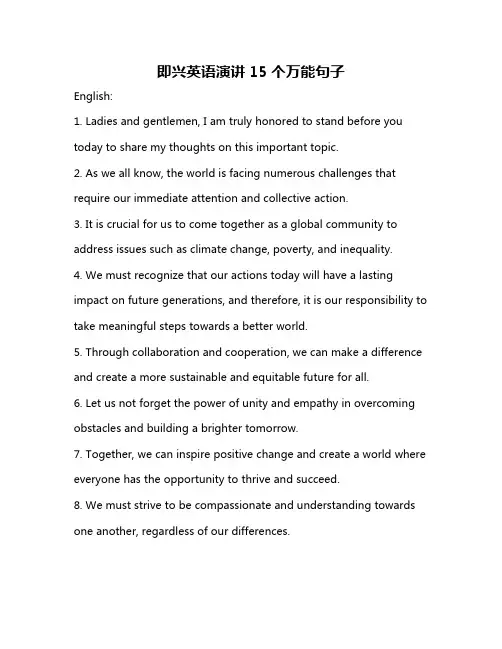
即兴英语演讲15个万能句子English:1. Ladies and gentlemen, I am truly honored to stand before you today to share my thoughts on this important topic.2. As we all know, the world is facing numerous challenges that require our immediate attention and collective action.3. It is crucial for us to come together as a global community to address issues such as climate change, poverty, and inequality.4. We must recognize that our actions today will have a lasting impact on future generations, and therefore, it is our responsibility to take meaningful steps towards a better world.5. Through collaboration and cooperation, we can make a difference and create a more sustainable and equitable future for all.6. Let us not forget the power of unity and empathy in overcoming obstacles and building a brighter tomorrow.7. Together, we can inspire positive change and create a world where everyone has the opportunity to thrive and succeed.8. We must strive to be compassionate and understanding towards one another, regardless of our differences.9. It is important to remember that every voice matters and that by working together, we can achieve great things.10. I urge you all to take action and be the change you wish to see in the world.11. Let us be leaders and role models in our communities, and empower others to join us in making a difference.12. As we embark on this journey towards a better future, let us never lose sight of our common humanity and the values that unite us.13. Together, we can build a world where peace, justice, and equality prevail, and where every individual is valued and respected.14. I am confident that with our collective efforts and dedication, we can overcome any challenge and pave the way for a brighter tomorrow.15. Thank you for your attention, and let us work together to create a world that we can all be proud of.中文翻译:1.女士们,先生们,我今天非常荣幸站在你们面前,分享我对这个重要主题的想法。
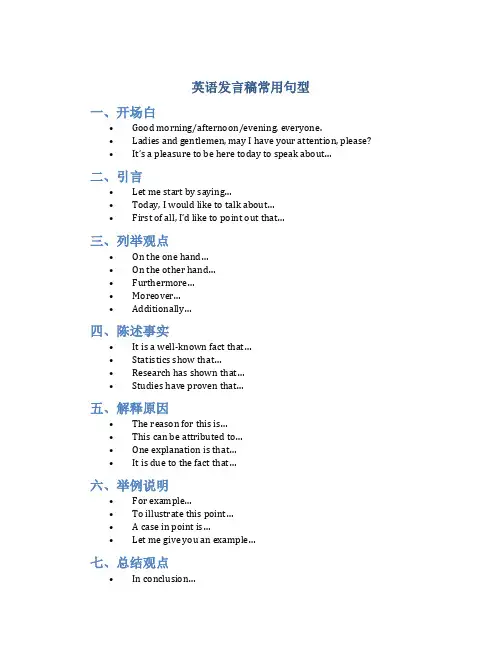
英语发言稿常用句型一、开场白•Good morning/afternoon/evening, everyone.•Ladies and gentlemen, may I have your attention, please?•It’s a pleasure to be here today to speak about…二、引言•Let me start by saying…•Today, I would like to talk about…•First of all, I’d like to point out that…三、列举观点•On the one hand…•On the other hand…•Furthermore…•Moreover…•Additionally…四、陈述事实•It is a well-known fact that…•Statistics show that…•Research has shown that…•Studies have proven that…五、解释原因•The reason for th is is…•This can be attributed to…•One explanation is that…•It is due to the fact that…六、举例说明•For example…•To illustrate this point…• A case in point is…•Let me give you an example…七、总结观点•In conclusion…•To sum up…•Therefore…•In summary…八、表达建议•It is important that we…•I would suggest that we…•We should consider…•One possible solution is to…九、结束语•Thank you for your attention.•I hope that I have been able to…•I look forward to your feedback.•Let’s work together to…以上是一些常用的英语发言稿句型,可以帮助您在演讲或发言时更加流利地表达观点和想法。
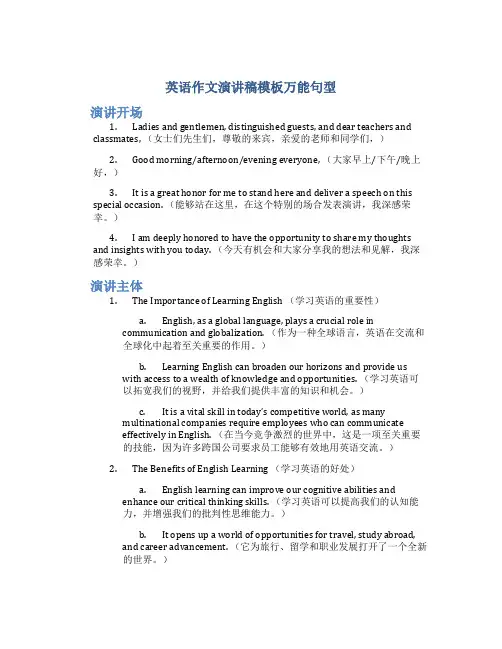
英语作文演讲稿模板万能句型演讲开场dies and gentlemen, distinguished guests, and dear teachers and classmates, (女士们先生们,尊敬的来宾,亲爱的老师和同学们,)2.Good morning/afternoon/evening everyone, (大家早上/下午/晚上好,)3.It is a great honor for me to stand here and deliver a speech on this special occasion. (能够站在这里,在这个特别的场合发表演讲,我深感荣幸。
)4.I am deeply honored to have the opportunity to share my thoughts and insights with you today. (今天有机会和大家分享我的想法和见解,我深感荣幸。
)演讲主体1.The Importance of Learning English (学习英语的重要性)a.English, as a global language, plays a crucial role incommunication and globalization. (作为一种全球语言,英语在交流和全球化中起着至关重要的作用。
)b.Learning English can broaden our horizons and provide uswith access to a wealth of knowledge and opportunities. (学习英语可以拓宽我们的视野,并给我们提供丰富的知识和机会。
)c.It is a vital skill in today’s competitive world, as manymultinational companies require employees who can communicateeffectively in English. (在当今竞争激烈的世界中,这是一项至关重要的技能,因为许多跨国公司要求员工能够有效地用英语交流。
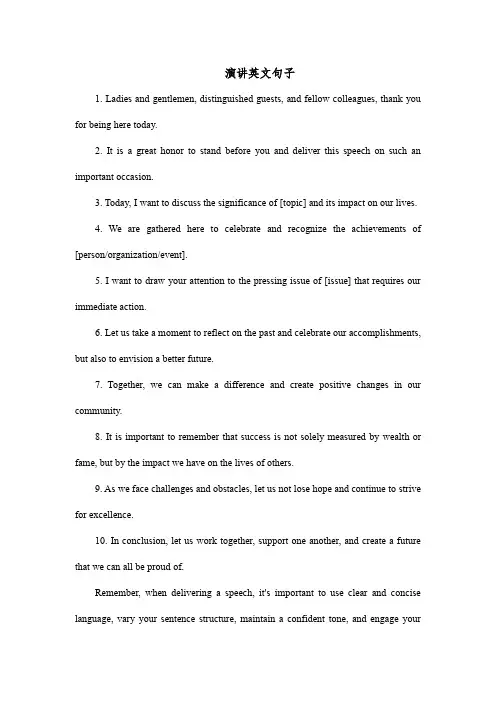
演讲英文句子1. Ladies and gentlemen, distinguished guests, and fellow colleagues, thank you for being here today.2. It is a great honor to stand before you and deliver this speech on such an important occasion.3. Today, I want to discuss the significance of [topic] and its impact on our lives.4. We are gathered here to celebrate and recognize the achievements of [person/organization/event].5. I want to draw your attention to the pressing issue of [issue] that requires our immediate action.6. Let us take a moment to reflect on the past and celebrate our accomplishments, but also to envision a better future.7. Together, we can make a difference and create positive changes in our community.8. It is important to remember that success is not solely measured by wealth or fame, but by the impact we have on the lives of others.9. As we face challenges and obstacles, let us not lose hope and continue to strive for excellence.10. In conclusion, let us work together, support one another, and create a future that we can all be proud of.Remember, when delivering a speech, it's important to use clear and concise language, vary your sentence structure, maintain a confident tone, and engage youraudience with relevant examples and stories. Good luck with your speech!。
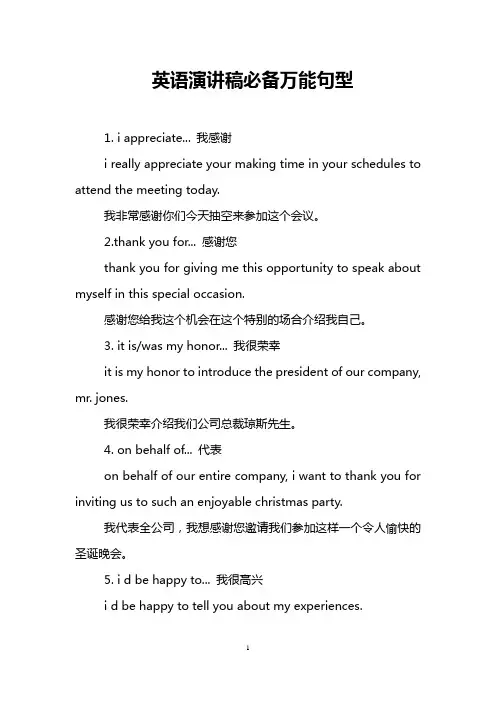
英语演讲稿必备万能句型1. i appreciate... 我感谢i really appreciate your making time in your schedules to attend the meeting today.我非常感谢你们今天抽空来参加这个会议。
2.thank you for... 感谢您thank you for giving me this opportunity to speak about myself in this special occasion.感谢您给我这个机会在这个特别的场合介绍我自己。
3. it is/was my honor... 我很荣幸it is my honor to introduce the president of our company, mr. jones.我很荣幸介绍我们公司总裁琼斯先生。
4. on behalf of... 代表on behalf of our entire company, i want to thank you for inviting us to such an enjoyable christmas party.我代表全公司,我想感谢您邀请我们参加这样一个令人愉快的圣诞晚会。
5. i d be happy to... 我很高兴i d be happy to tell you about my experiences.我很高兴和你们分享我的经验。
6. what i am going to talk about today is... 今天我想讲的是what i am going to talk about today is the energy conservation issue.今天我想讲的是节能问题。
7. how can we...? 我们怎样才能?how can we work more efficiently?我们怎样才能工作得更有效率呢?8.thank you from the bottom of my heart for... 我从心底感谢thank you from the bottom of my heart for giving me this chance to speak to you today.我从心底感谢你们今天给了解这个机会在你们前面讲话。
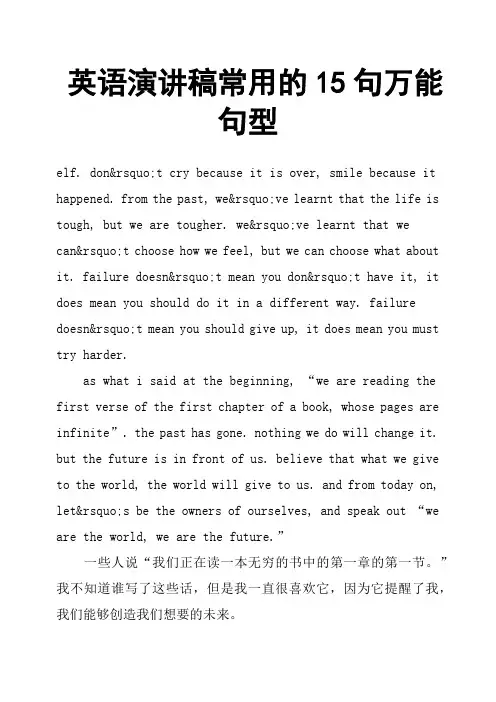
英语演讲稿常用的15句万能句型elf. don’t cry because it is over, smile because it happened. from the past, we’ve learnt that the life is tough, but we are tougher. we’ve learnt that wecan’t choose how we feel, but we can choose what about it. failure doesn’t mean you don’t have it, it does mean you should do it in a different way. failure doesn’t mean you should give up, it does mean you must try harder.as wha t i said at the beginning, “we are reading the first verse of the first chapter of a book, whose pages are infinite”. the past has gone. nothing we do will change it. but the future is in front of us. believe that what we give to the world, the world will give to us. and from today on, let’s be the owners of ourselves, and speak out “we are the world, we are the future.”一些人说“我们正在读一本无穷的书中的第一章的第一节。
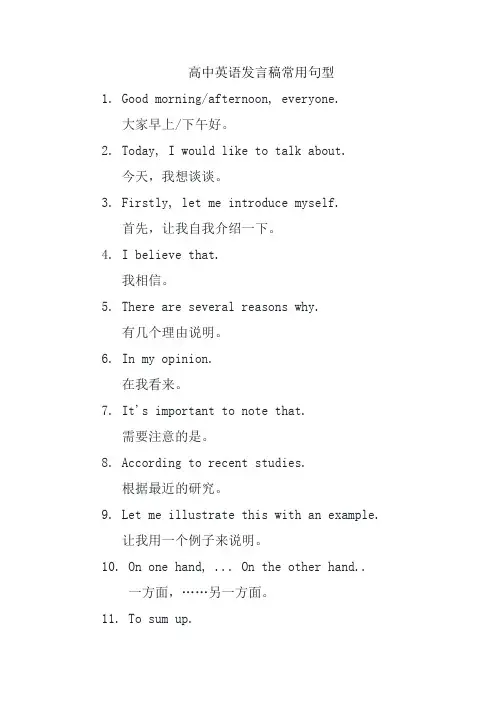
高中英语发言稿常用句型1. Good morning/afternoon, everyone.大家早上/下午好。
2. Today, I would like to talk about.今天,我想谈谈。
3. Firstly, let me introduce myself.首先,让我自我介绍一下。
4. I believe that.我相信。
5. There are several reasons why.有几个理由说明。
6. In my opinion.在我看来。
7. It's important to note that.需要注意的是。
8. According to recent studies.根据最近的研究。
9. Let me illustrate this with an example.让我用一个例子来说明。
10. On one hand, ... On the other hand..一方面,……另一方面。
11. To sum up.总结来说。
12. In conclusion.最后。
13. I would like to emphasize that.我想强调的是。
14. This is a pressing issue that needs our attention.这是一个亟需我们关注的问题。
15. Let's take a closer look at.让我们更仔细地看一下。
16. As we all know.正如我们所知道的。
17. This leads us to the next point.这引出了下一个要点。
18. I urge everyone to.我呼吁大家.19. It’s essential to consider.考虑……是至关重要的。
20. I encourage you all to think about.我鼓励大家考虑。
21. In light of this information.鉴于这些信息。
【英文演讲】十大经典英语演讲句型十大经典演讲句型1. I am honored to... 我很荣幸……这是演讲的第一大王牌句型,几乎每一场演讲都要以这个句型作为开场白。
有人提出,这个句型已经到了陈词滥调(cliche)的地步。
但是,谦虚永远是一种美德,这个句型之所以能被古今中外无数演讲大师所采用,当然有其吸引人的地方。
Top 1: I am honored to have a chance to speak to you today.(我今天很荣幸跟大家讲几句。
)Top 2: I am honored to be here on such a special occasion.(我很荣幸在这个特别的时刻来到这里。
)【编者注】这个句型也可以说成“It’s my (great) honor to...”Top 3: I am honored to introduce the fuonder of Crazy English,Mr.Li Yang.(我很荣幸地为大家介绍疯狂英语创始人—李阳先生。
)2. Words can’t express... 言语表达不了……Words can’t express how lucky I am.(简直不能用言语来表达我有多幸运。
)Words can’t express how thankful I am.(言语表达不了我的感激之情。
)3.Today I want to talk to you about... 今天我想跟你们谈谈……演讲都有个主题,如何在演讲中介绍自己的主题呢?这个句型是最常用的。
Today I want to talk to you about a very important subject.(今天我将和你们谈一个非常重要的话题。
)Today I want to talk to you about the future of business in China. (今天我将和你们谈一谈中国的商业前景问题。
★以下是®⽆忧考⽹英⽂写作翻译频道为⼤家整理的《英语演讲稿15个万能句型》,供⼤家参考。
1. I appreciate… 我感谢…… I really appreciate your making time in your schedules to attend today. 我⾮常感谢你们今天抽空来参加这个会议。
2.Thank you for… 感谢您…… Thank you for giving me this opportunity to speak about myself in this special occasion. 感谢您给我这个机会在这个特别的场合介绍我⾃⼰。
3. It is/was my honor… 我很荣幸…… It is my honor to introduce the president of our company, Mr. Jones. 我很荣幸介绍我们公司总裁琼斯先⽣。
4. On behalf of… 代表…… On behalf of our entire company, I want to thank you for inviting us to such an enjoyable Christmas party. 我代表全公司,我想感谢您邀请我们参加这样⼀个令⼈愉快的圣诞晚会。
5. I’d be happy to…我很⾼兴…… I’d be happy to tell you about my experiences. 我很⾼兴和你们分享我的经验。
6. What I am going to talk about today is… 今天我想讲的是…… What I am going to talk about today is the energy conservation issue. 今天我想讲的是节能问题。
7. How can we…? 我们怎样才能……? How can we work more efficiently? 我们怎样才能⼯作得更有效率呢? 8.Thank you from the bottom of my heart for…我从⼼底感谢…… Thank you from the bottom of my heart for giving me this chance to speak to you today. 我从⼼底感谢你们今天给了解这个机会在你们前⾯讲话。
英语演讲稿中常用短语篇一:英文演讲Presentation常用语做presentation,我们要注意对话题的准备以及态度和身体语言等等,除此之外,我们还应该掌握一些常用句型。
1. Right, let's get started.2. Let me introduce myself.3. I've divided my presentation into three main parts.4. Just to give you a brief overview.5. I'll be saying more about this in a minute.6. I'm sure the implications of this are clear to all of us.7. There's an important point to be made here.8. OK, let's move on. (go on to make your next point)9. As you can see, the figures speak for themselves.10. To go back to what I was saying earlier.11. Are there any questions you'd like to ask at this point?12. I'd like to look at this in more detail.13. Let's put this into perspective. (to explain it this way)14. Perhaps I should expand on that a little.15. To digress for a moment? (to depart from your plan)16. So, to sum up?17. That brings me to the end of my talk.18. Thank you. I'm sure you all have lots of questions.美国人经常挂在嘴边的话thousand times no! 绝对办不到!Don't mention it. 没关系,别客气。
英语发言稿常用句型结构一、引言在英语演讲或发言中,运用恰当的句型结构能够让语言更具表现力和吸引力。
本文将介绍一些英语发言稿常用的句型结构,帮助您更好地表达和传达自己的想法。
二、表达观点1.表示观点:In my opinion, …2.引用观点:As is well-known, …3.从逻辑上支持观点:It can be seen that …4.批判观点:On the contrary, …三、举例论证1.举例论证:For example, …2.详细阐述:To illustrate this point, …3.表示普遍性:It is widely accepted that …四、引用名人名言1.引用名人名言:As the saying goes, …2.进一步解释:This quote implies that …3.反思引言:This quote prompts us to reflect on …五、作出建议1.提出建议:I suggest that …2.小贴士:One simple solution is …3.用句型表示期待:We look f orward to …六、总结1.总结内容:To sum up, …2.强调重点:The most important thing to remember is …3.提出展望:Looking ahead, …七、结束语通过运用以上句型结构,我们可以更加流畅地表达自己的观点和想法,让英语发言更加具有说服力和魅力。
希望这些句型能够为您的英语发言稿带来更好的效果。
八、致谢感谢您的阅读,希望这篇文章对您有所帮助。
以上是关于英语发言稿常用句型结构的介绍,希望能够为您提供一些启发和指导。
愿您在未来的英语演讲中表现出色!。
英语演讲稿常用的15句万能句型1. i appreciate... 我感谢i really appreciate your making time in your schedules to attend the meeting today.我非常感谢你们今天抽空来参加这个会议。
2.thank you for... 感谢您thank you for giving me this opportunity to speak about myself in this special occasion.感谢您给我这个机会在这个特别的场合介绍我自己。
3. it is/was my honor... 我很荣幸it is my honor to introduce the president of our company, mr. jones.我很荣幸介绍我们公司总裁琼斯先生。
4. on behalf of... 代表on behalf of our entire company, i want to thank you for inviting us to such an enjoyable christmas party.我代表全公司,我想感谢您邀请我们参加这样一个令人愉快的圣诞晚会。
5. i d be happy to... 我很高兴i d be happy to tell you about my experiences.我很高兴和你们分享我的经验。
6. what i am going to talk about today is... 今天我想讲的是what i am going to talk about today is the energy conservation issue.今天我想讲的是节能问题。
7. how can we...? 我们怎样才能?how can we work more efficiently?我们怎样才能工作得更有效率呢?8.thank you from the bottom of my heart for... 我从心底感谢thank you from the bottom of my heart for giving me this chance to speak to you today.我从心底感谢你们今天给了解这个机会在你们前面讲话。